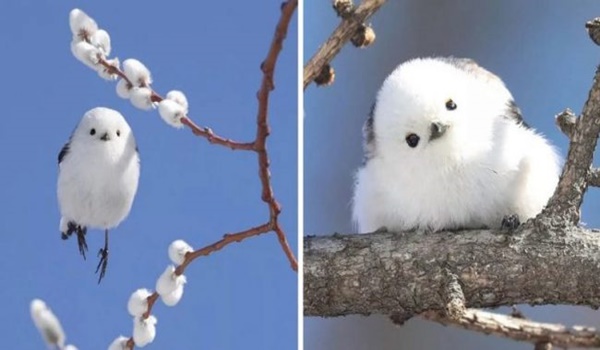Japan is the ultimate destination for many people. It is the country of sushi, unique culture, and traditions, tea ceremonies, temples, calligraphy and origami, kimonos, manga, anime, sculpture, poetry, flower arranging.. this list is simply endless!
If you ever visit the volcanic island of Hokkaido, Japan’s most northernmost island, don’t be surprised to see a white flying ball in the air!
It’s an unusual long-tailed tit bird that lives there, and looks exactly like a cotton ball with black eyes!
These birds live in other regions in Asia and Europe as well, but the species that lives on this island has a pure white face and a cotton-wool-like body. In other areas, these birds have grey and brown feathers with the white ones or have no white ones at all.
Hokkaido has 17 quasi-national and prefectural parks and six national parks and is popular due to the numerous endemic species found there.
The island is the home of various wildlife, and animals are comfortable with being surrounded by numerous tourists. These cotton ball birds are social and can even land on your shoulder!
The Japanese are obsessed with these adorable little birds!
Floating cotton balls

The Shima-enaga birds, as they are nicknamed, move in large flocks, and they make recognizable calls to the group members, that sound like ‘si-si-si-si.’
They are mostly found in mixed woodland, but they can live anywhere from parks and farms to river grasslands and thick forests.
They are vulnerable to cold winter weather, so to ensure their survival, they need reliable access to energy-rich food during the short days, and can be often seen around gardens.
Yet, during spring, they move out into the countryside to breed.
In adulthood, these birds are 13–15 cm long in adulthood and weigh between 7–9 grams. They have an immaculately white face and neck with a stream-lined body, and a long, dark-colored tail.
These birds live a communal life, as nesting alone is very difficult. After breeding season in July-February, the birds join forces with about 7-15 other birds which they usually interact with.
They nest in thick shrub bushes or tree branches. Some members search for food, while others remain to take care of the babies.

If you want to have closer contact with these friendly and sweet birds, don’t forget to offer them some treats, like seeds, peanuts, breadcrumbs, or pizza crusts!
So, cuteness just got a new name!




